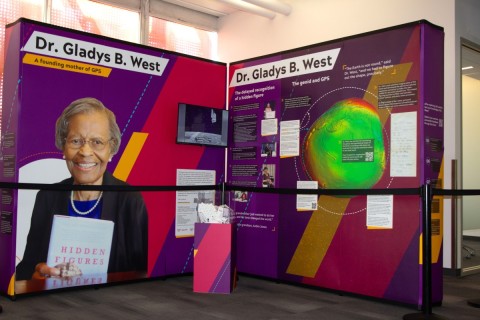Library Newsroom

Dr. Gladys West, a pioneering mathematician who made key contributions to the development of modern GPS technology, is the subject of a new Auraria Library traveling exhibition at the top of the stairwell on the northwest side of the library’s 2nd floor.
The four giant panels and video display that comprise the exhibition tell the compelling story of Dr. West’s life, highlighting her personal and professional accomplishments. She was born in 1930 to a sharecropping family in rural Virginia, and she saw education as a path to a life different from that of her family and most Black Americans of the time.
In the 1950s, she became the second Black woman ever hired to work at the U.S. Naval Proving Ground, where she excelled in calculating complex mathematical equations, and later became project manager for the first satellite designed for remote sensing of the world’s oceans.
Though she was not directly featured in the namesake Hollywood film, she has become increasingly recognized as a “Hidden Figure” of the late 20th century, associated with a handful of black women who made essential mathematical contributions to crucial American innovations.
The exhibition was initially launched by the National Center of Women’s Innovations in West’s home state of Virginia, and is supported by Trimble, a GPS technology firm that partners with CU Denver on a campus technology laboratory. The Dr. West exhibition will be at the Auraria Library through this academic year.
"Dr. West's contributions in GPS have impacted how our entire world functions, and she stands out as a beacon of the accomplishments of women in STEM,” said Kenneth Sisco, interim lab manager for the Trimble Lab in the College of Engineering, Design, and Computing. “We are grateful for our partnership with Trimble to connect us with the National Center of Women's Innovations and help our students learn the history of the technology they are learning and developing upon today."











